Air India Flight AI-171 Crash: Understanding the Mayday Call

Air India Flight AI-171 Incident Overview
The distress signal "Mayday, Mayday!" was transmitted just moments before the Air India flight AI-171, a Boeing 787-8 Dreamliner, tragically crashed near Ahmedabad shortly after its departure. The aircraft, which was en route to London Gatwick, had 242 individuals, including passengers and crew, on board when it went down in the Meghani Nagar area just minutes after taking off.
The flight departed from Sardar Vallabhbhai Patel International Airport around 1:38 PM IST. Just two minutes before the incident, the pilot issued a Mayday call, indicating a critical emergency. Communication was lost within a minute of this call, and the aircraft subsequently descended rapidly before crashing.
What Does a 'Mayday' Call Mean?
"Mayday" is an internationally recognized distress signal used in voice communication to indicate a life-threatening emergency, primarily in aviation and maritime contexts. The term originates from the French phrase "m'aidez," which translates to "help me." A Mayday call is repeated three times—"Mayday, Mayday, Mayday"—to ensure clarity and priority in radio communications.
When a Mayday call is made, all air traffic is immediately cleared to prioritize the distressed flight for emergency assistance, whether it involves returning to the airport, landing at the nearest available runway, or receiving on-ground emergency support.
In the case of AI-171, the Mayday was declared after the aircraft had only ascended to 625 feet, significantly lower than standard climbing altitudes. The plane experienced a stall and plunged uncontrollably, ultimately crashing to the ground.
